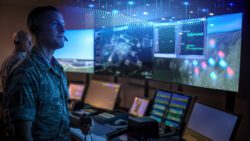Charles River Analytics, a developer of intelligent systems solutions, announces a contract to develop a system for the National Aeronautics and Space Administration (NASA). The system known as DIPSARS, for the Discovery of Interesting Patterns and Semantic Analysis in Remote Space, detects large-scale environmental events from satellite imagery. These events include volcanic eruptions, storms, and algae blooms, captured in images such as those produced from the NASA Earth Observing-1 (EO-1) satellite, as seen in the figure below.
The volume of satellite and rover data collected by NASA has grown dramatically as new missions are launched with ever-increasing sensor payloads. The data to be processed by DIPSARS includes different scenes and objects that research scientists and mission controllers use to determine which areas should be explored further. The sheer volume of data, combined with bandwidth limitations, is driving a need to process and analyze which data is relevant, important, and interesting enough to prompt follow-on action, all in real-time onboard the spacecraft.
DIPSARS leverages Charles River’s Object Detection Framework (ODF), a capability developed over several years to address the computer vision market. The ODF is a generalized detection framework that can detect objects and phenomena in image data in real-time. “DIPSARS will expand the use of our state-of-the art detection framework to new platforms and data,” said Tom Moore, the lead software engineer for the project.
“We’re excited by the potential of this project to enable autonomous decisions by satellites, resulting in fewer missed opportunities to observe significant events,” said Daniel Stouch, Principal Investigator on the project. “It will also free up valuable communications bandwidth that can then be used to transmit data of interest back to NASA and the research community in a more timely fashion.”




